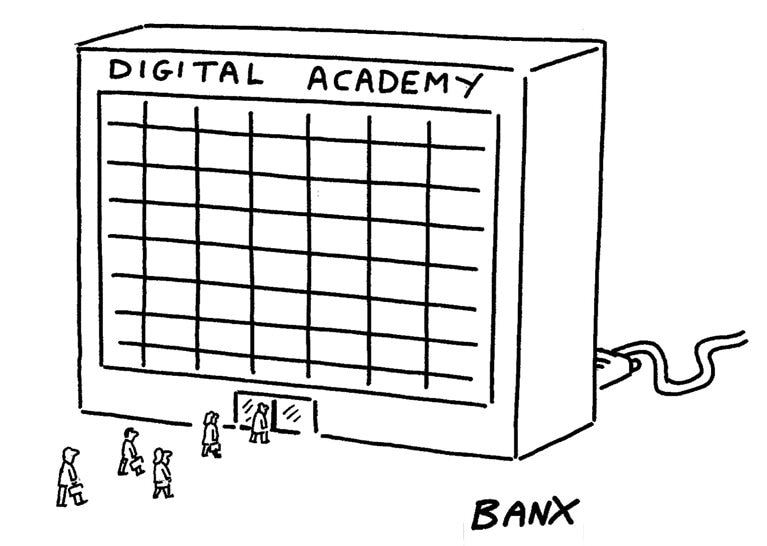If there’s one thing a digital strategy can’t be, it’s incremental. The mismatch between most incumbents’ business models and digital futures is too great—and the environment is changing too quickly—for anything but bold, inventive strategic plans to work.
Unfortunately, most strategic-planning exercises do generate incrementalism. We know this from experience and from McKinsey research: on average, resources don’t move between business units in large organizations. A recent book by our colleagues, Strategy Beyond the Hockey Stick, seeks to explain what causes this inertia (strategy’s social side, rooted in individual interests, group dynamics, and cognitive biases) and to suggest a way out (understanding the real odds of strategy and overhauling your planning processes to deliver the big moves that can overcome those long odds).
All this holds doubly true for digital strategy, which demands special attention. Leaders in many organizations lack clarity on what “digital” means for strategy. They underestimate the degree to which digital is disrupting the economic underpinnings of their businesses. They also overlook the speed with which digital ecosystems are blurring industry boundaries and shifting the competitive balance. (For more on why companies often fall short, see “Why digital strategies fail.”) What’s more, responding to digital by building new businesses and shifting resources away from old ones can be threatening to individual executives, who may therefore be slow to embrace (much less drive) the needed change.
In our experience, the only way for leaders to cut through inertia and incrementalism is to take bold steps to fight and win on four fronts: You must fight ignorance by using experiential techniques such as “go-and-sees” and war gaming to break leaders out of old ways of thinking and into today’s digital realities. You must fight fear through top-team effectiveness programs that spur senior executives to action. You must fight guesswork through pilots and structured analysis of use cases. And you must fight diffusion of effort—a constant challenge given the simultaneous need to digitize your core and innovate with new business models.
In this article, we will describe how real companies are winning each of these fights—overcoming inertia while building confidence about how to master the new economics of digital. You can join these companies in that effort, thereby giving your digital strategy a jolt and accelerating the shift of your strategy process as a whole, from old-fashioned annual planning to a more continuous journey yielding big moves and big gains even when the end point isn’t entirely clear.
1. Fighting ignorance

Many senior executives aren’t fully fluent in what digital is, much less up to speed on the ways it can change how their businesses operate or the competitive context. That’s problematic. Executives who aren’t conversant with digital are much more likely to fall prey to the “shiny object” syndrome: investing in cool digital technologies (which might only be relevant for other businesses) without a clear understanding of how they will generate value in the executives’ own business models. They also are more likely to make fragmented, overlapping, or subscale digital investments; to pursue initiatives in the wrong order; or to skip foundational moves that would enable more advanced ones to pan out. Finally, this lack of grounding slows down the rate at which a business deploys new digital technologies. In an era of powerful first-mover advantages, winners routinely lead the pack in leveraging cutting-edge digital technologies at scale to pull further ahead. Having only a remedial understanding of trends and technologies has become dangerous.
Raising your technology IQ
For inspiration on how to raise your company’s collective technology IQ, consider the experience of a global industrial conglomerate that knew it had to digitize but didn’t think its leadership team had the expertise to drive the needed changes. The company created a digital academy to help educate its leadership about relevant digital trends and technologies and to provide a forum where executives could ask questions and talk with their peers. Academy leaders also brought in external experts on a few topics the company lacked sufficient internal expertise to address.
Supplementing the academy effort (aimed at leaders) was an organization-wide assessment of digital capabilities and an evaluation of the company’s culture. This provided a fact base, which everyone could understand, about what the organization needed to build over the course of the digital transformation. As business leaders developed digital plans, they were accountable for explaining and defending them to other executives. They also had to help gather those plans into an enterprise-wide digital strategy that every business leader understood and had helped to create.
Overcoming competitive blind spots
If your company resembles many we know, it’s still stuck in some old ways of thinking about where money gets made and by whom. You’re also likely to be overlooking ways digital is changing both the economics of the game and the players on the field in your industry. If any of this sounds familiar, you probably need a jolt—something that forces you to think differently about your business. More specifically, you need to start thinking about it as digital disruptors do. In our experience, this demands a process that begins with a sprint to get everything moving, to see what your industry (and your company’s role in it) could look like if you started from scratch, and to redraw your road map.
The financing division of a European financial-services company went through such a process when it tried to understand digital’s impact on its current lines of business. For example, a conversation began in the auto-loans division with the question “how can we make it easier for people to get their loans online?” It turned into a deeper examination of “how does our business model change if people stop buying cars and start buying mobility?” Similarly, an auto insurer might move from asking “how can I sell car insurance online better” to “what does car insurance mean in the context of autonomous vehicles?” There’s no substitute for exploring such questions, which emerge when digital, regulatory, and societal trends collide with today’s value chain (for more on these collisions, see “Digital strategy: Understanding the economics of disruption”).
Would you like to learn more about McKinsey Digital?
Once the new realities are discovered, companies should speed up the process of understanding how other players—including nontraditional ones—will respond. The financial-services provider jump-started things by holding a series of war-gaming workshops. It divided its leadership team into groups and assigned them to role-play potential attackers such as Amazon, Google, or small, cherry-picking start-ups. Seeing through the eyes of “baggage-free” attackers inspires an awareness of how players with very different core competencies are likely to act in the new landscape. It can also propel a shared sense of urgency to change the old ways of thinking and acting.
These sessions radically changed the way the company’s leaders thought about their business, their industry, and the digital shifts remaking both. The end result was a set of leading-edge ideas for deploying digital to make the current operating model faster and more effective, for investing in new digital offerings, for designing and launching a new digital ecosystem to meet the emerging needs of digital consumers, and for partnering with start-ups beginning to emerge as leading players in advanced mobility.
2. Fighting fear

Getting left behind by digital first movers can be hazardous to your company’s future. But many of your executives may perceive responding to digital—making the big bets, building new businesses, shifting resources away from old ones—as hazardous to their own future. As we’ve noted, that exacerbates the social side of strategy and breeds strategic inertia. If you want to make big digital moves, you must fight the fear that your top team and managers will inevitably experience.
From what we have seen, this kind of fight doesn’t happen organically. You need to design a programmatic effort with the same rigor you would insist on to redesign key processes across your organization. This typically involves making a clear case that executives can’t hide from the changes digital is bringing and that encouraging and accelerating change—rather than chasing it—can create more value. Then you need to give executives the tools and support network they must have to succeed as leaders of that journey. Many companies focus on the extensive detailing of digital-initiative plans but skip the critical step of building an equally rigorous program to sustain the leaders driving change.
Honest dialogue
At the industrial company we discussed earlier, the move to digital implied significant change in the characteristics leaders required to be effective. Naturally, concerns about waning influence, or worse, followed for many of the company’s 20 or so business-unit leaders. The industrial conglomerate confronted these fears head-on by organizing a top-team effectiveness program to surface anxieties, build awareness of how they were affecting decision making, and define how leaders could remain relevant. In workshops, executives discussed the specific mind-sets and behavioral shifts needed to gain “ownership” of digital initiatives as a group and to become role models for their organizations.
Support networks
Leaders also formed communities that cut across their businesses, initially to share best practices and coordinate the timing of implementation. Over time, the role of these communities grew to include skill-building activities, such as bringing in speakers with specialized capabilities and motivational messages and organizing Silicon Valley go-and-sees that reinforced the importance of leading digital change. The communities also provided peer support to help teams navigate the new landscape.
We have seen other organizations similarly coalesce around digital-leadership training (sometimes supported by digital advisory boards) that helps executives to become comfortable with—even embrace—the uncertainty of the destination and the career trade-offs needed for a well-executed digital strategy. These support networks dovetail with, and bolster, the digital IQ–raising efforts we described earlier. Indeed, we find that leaders who understand the shifting economics also understand that their careers will be affected one way or another.
3. Fighting guesswork

Pursuing an aggressive digital strategy involves leaps into the unknown: simultaneously, you are likely to be moving into new areas and overhauling existing businesses with new technologies. What’s more, in many digital markets, the premium of being a first mover makes it necessary not only to shift direction but also to do so faster than your peers. The combination of ambiguity and the need for speed sometimes gives rise to guesswork and moves that are hasty or poorly thought out—and to anxiety about whether a move isn’t going to work or just needs more time.
Building the proof points as you go
One way to fight guesswork is to anchor your strategy decisions to a thesis about the business outcomes that different digital investments will produce. This is less about elaborate business-school modeling and more about thinking that draws fast, ground-level lessons from the data to determine whether your business logic is correct. Put another way, it means figuring out if there is sufficient value to make it worthwhile to invest something—as part of a process of learning even more. This approach increases the odds of successful implementation: a well-articulated view of the outcomes means that you can track how well the strategy is working. It also makes it easier to assess whether the new direction is worth it in terms of both financial capital and organizational pain.
Those proof points must be grounded in digital reality. Consider the experience of a global oil and gas company investigating the potential impact of several advanced technologies on its business. Rather than develop theoretical value-creation scenarios, the company’s digital center of excellence got busy exploring: How might sensors, robots, and artificial intelligence improve productivity and safety in unmanned operations? What operating hurdles, such as skill gaps among managers and frontline workers, would need to be overcome?
“Skunkworks” efforts began to give the company sharper insights into the timetables and financial profiles of different investments, so it avoided both the “finger in the air” syndrome (which dooms some digital efforts) and excessive modeling (which bogs down others). The end result was a value-thesis projection of a pretax cash-flow improvement exceeding 20 percent by 2025. That built the confidence of senior leaders and the board alike.
Pilots and stage gates
A second way to reduce the need for guesswork is to take full advantage of real-time data and the opportunities they provide for experimentation. Digital does amplify the gut-wrenching uncertainty by multiplying the strategic choices leaders face while reducing the time frame for making and implementing those decisions. But it also contains a silver lining: the potential for gaining rapid, data-driven insights into how things are going. Information on the progress of a product launch, for example, is available in days rather than months. That makes rapid course corrections possible and, ultimately, considerably improves the chances of success.
The oil and gas company mentioned earlier got a rapid bead on the impact that its digital initiatives were having on its business performance when it automated the evaluation of several business cases. Testing was more or less continuous, which reduced the level of anxiety about the investments, because executives had hard data on how things were performing rather than relying on guesses or intuition in realms they didn’t know extremely well. It also gave them more confidence to push cutting-edge solutions: they didn’t need to see how other oil and gas companies did things when they could move first and see, in near real time, what worked and what didn’t.

Why digital strategies fail
An important element of this nimble approach was breaking up big bets into smaller, staged investments. While the oil and gas company was ready to invest in digital, it was decidedly uncomfortable with throwing money at a problem and hoping for the best. It therefore developed a series of rigorous stage gates for investments managed by a new, central digital-transformation office. The office was charged with overseeing the portfolio of digital investments to ensure that the most promising projects were funded and others defunded before they soaked up valuable resources. In tandem, the head of the company’s digital efforts was vested with the responsibility for approving which ideas would move to initial development, basing these decisions on the organization’s overall vision for digital.
The ideas, which originated mostly with the business units, included clear requirements for testing. The “fail fast” mind-set was embedded from the outset because it allowed the company to learn quickly from mistakes and to minimize wasted funding. Another payoff was that the central team could identify synergies, which allowed the development costs of some investments to be shared rather than borne by a single business. These processes helped temper some of the risks of the bold investments the company was making, gave leaders the confidence to venture ahead as first movers, and kept open the option to correct course quickly when the data pointed in another direction.
4. Fighting diffusion

Effective strategy requires focus, but responding to digital inevitably risks diffusion of effort, or “spreading the peanut butter too thinly.” Most companies we know are trying, and struggling, to do two things at once: to reinvent the core by digitizing and automating some of its key elements, for example, and to create innovative new digital businesses. The challenge is acute because of the dizzying pace of digital change and the uncertainty surrounding the adoption of new technology. Even if the technology for autonomous vehicles pans out, for instance, when will the majority of people really begin to use them? Given the impossibility of knowing, it’s easy to wind up with an unfocused hodgepodge of digital initiatives—a far cry from a strategy.
Two concepts can help you navigate. First, view your company as a portfolio of initiatives at different stages of seeding, nurturing, growing, or pruning. Our colleague Lowell Bryan championed this view upward of 15 years ago, and it is more relevant than ever in our digital age because the opportunities, time frames, and economics of core businesses can be very different from those of new ones—so resources and efforts shouldn’t be applied uniformly.
Second, embrace the necessity of “big moves,” such as the dramatic reallocation of resources, sustained capital investment, radical productivity improvements, and disciplined M&A. As our colleagues have shown, successful market-beating strategies nearly always rest on such moves. Making them mutually reinforcing, so that developments in the core help to support new digital businesses and vice versa, is a critical part of managing the risks of diffusion.
To understand what the application of these ideas looks like in practice, consider the experience of a global IT-services company wrestling with how much to invest in digital over the next five years (rather than use standard R&D funding across all of the company’s business lines). That meant scrutinizing which traditional businesses faced obsolescence as a result of digital, whether digital could stretch any of those lifetimes (or if immediate divestment was preferable), which new digital businesses to invest in, and how much to invest.
A portfolio approach
As a first step, the company went through its portfolio business by business, focusing on three questions: Which emerging digital products and services were missing from the portfolio? Which product offerings and elements of the existing operating model should be digitized or fully digitally reengineered to improve customer journeys? And what areas should be abandoned? The answers for the company’s healthcare markets differed from those for banking, but the company became comfortable with hard choices and more attuned to new opportunities by tying all decisions to clear use cases.
As part of this exercise, the company developed scenarios for how the value pools in each of its industry verticals would probably shift across component customer value chains. It wanted to get a sense of the types of services that clients and potential clients were likely to demand and thus might try to obtain from new suppliers or IT outsourcers. For businesses where more revenue would be likely to shift, the company was comfortable placing bigger bets on new digital offerings, in contrast with its approach to businesses where the revenue at stake wasn’t changing as much.
Big, mutually reinforcing moves
This systematic evaluation of value-pool opportunities across the portfolio generated a frank discussion of how the organization’s risk appetite had to change. It also catalyzed a greater willingness to invest in new digital businesses—which the company did, to the tune of more than $1.5 billion. As part of this strategic evolution, the company launched an aggressive program to better leverage foundational digital capabilities, such as automation, advanced analytics, and big data. These capabilities, to be sure, were key building blocks for the new digital businesses. Just as important, however, by deploying the capabilities at scale across existing businesses, the company was better able to stretch the life of its core offerings.
The portfolio strategy paid dividends both in revenue gains and cost reductions. For example, investing in a balanced fashion between core and new businesses led to faster than expected revenue streams from new offerings. The company estimated that 40 percent of its revenues would flow from them within two to three years. Moreover, its digitally improved core businesses, with a sizable base of existing customer revenues, provided additional funding for the new digital portfolio. That increased the leadership’s commitment to the strategy, bolstering confidence that the new portfolio offerings would provide growth more than compensating for the eventual decline of core businesses.
Your best digital competitors—the ones you really need to worry about—aren’t taking small steps. Neither can you. This doesn’t mean that a digital strategy must be designed or put to work with any less confidence than strategies were in the past, though. Strategy has always required closing gaps in knowledge about complex markets, inspiring executive teams (and employees) to go beyond their fears and reluctance to act, and calibrating risks when you bet boldly.
The good news is that the digital era, for all its stomach-churning speed and volatility, also serves up more information about the competitive environment than yesterday’s strategists could ever imagine. Simultaneously, analytically backed, rapid test-and-learn approaches have opened up new avenues to help companies correct course while staying true to their strategic goals. Today’s leaders need to step up by persuading their organizations that digital strategies may be tougher than other strategies but are potentially more rewarding—and well worth the bolder bets and cultural reforms required, first, to survive and, ultimately, to thrive.


